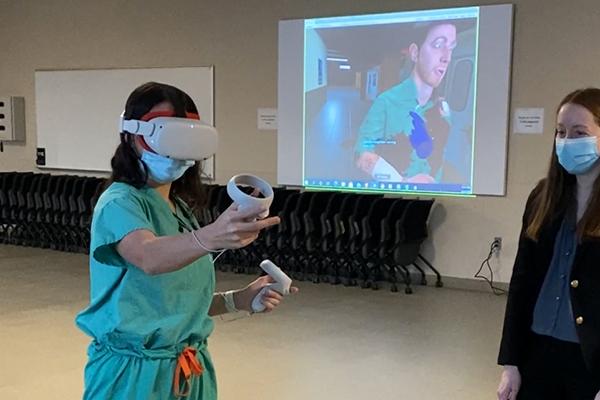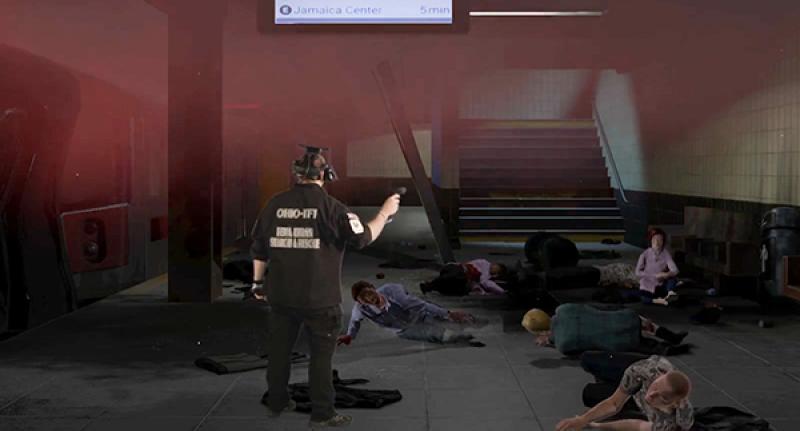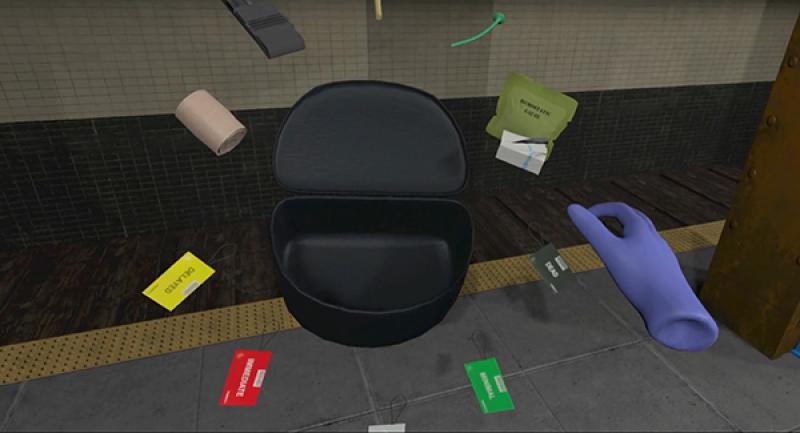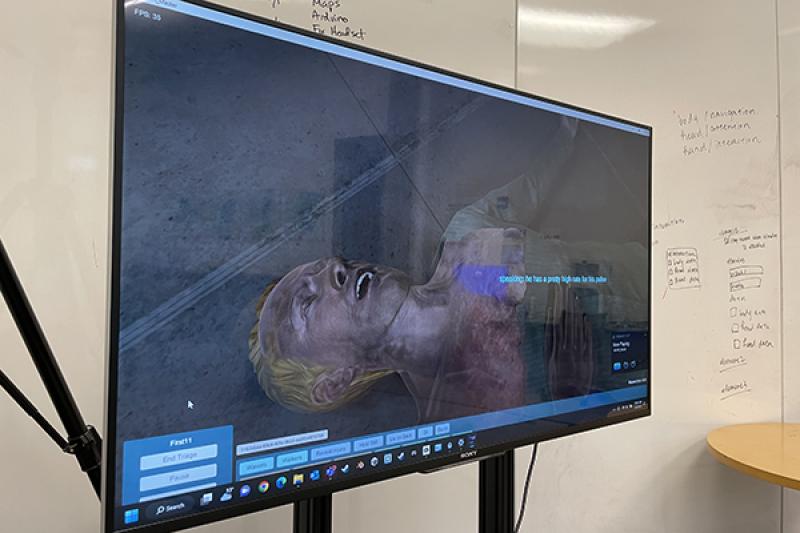ACCAD builds virtual reality program to help first responders simulate triage during disasters


Scenario: There has a been a subway explosion. You are a trained first responder. A dozen people are injured on the platform in front of you, and you must figure out who to help first. Where do you begin? How does the stress of that situation impact your judgement? Are you able to provide medical aid quickly and accurately?
That triage scenario is tragic, but it’s also very real. Training first responders how to act in situations like this can be expensive, time consuming and difficult to repeat.
But thanks to an immersive new virtual reality program developed by Ohio State’s Advanced Computing Center for the Arts and Design (ACCAD) and the College of Medicine, first responders can now get quick, repeatable training for disaster scenarios.
“The idea is that when you have a group of people who have been injured and you have limited resources, you need to quickly prioritize who you are going to help first and who you're going to help later,” said Vita Berezina-Blackburn, a senior creative technologist at ACCAD who worked on the project. “It's the rapid decision-making when you have multiple patients that is really difficult for [first responders] to practice.”
The project, successfully completed after five years of development and user testing, places a trainee in the middle of a chaotic scene. The trainee dons a VR headset and holds a controller in each hand, allowing them to interact with their environment.
When the simulation begins, trainees are transported to a subway station rendered in high-quality graphics. People lie on the floor with varying injuries. Some are minor, some are catastrophic. The trainee can give the patients verbal commands with voice recognition technology, walk up to them, check their pulse and administer multiple types of first aid with a virtual triage kit that hovers at their side. Trainees can also tag the injured people with different-colored labels to indicate the severity of their injury for the next responders on the scene.
From start to finish, the entire program might take a trainee 15-20 minutes. Compared to “Disaster Day” training scenarios that involve complex set-building, large amounts of space and paid actors, the benefits of ACCAD’s virtual reality program are easy to see. And the program has benefits for the trainees as well as the organizations running simulations.
“This gets the trainee an impression of what it would be like to enter into this environment, taking the edge off” said Jeremy Patterson, a senior graphics researcher at ACCAD. “So the first time — hopefully they never encounter a situation like this — but if they do, they're not taken aback by what it looks like with smoke and the injured patients.”
The new software, known as First Responder VR, has its roots in an interactive training program called “Virtual Patient” that was created in another collaboration between ACCAD’s Alan Price and Dr. Douglas Danforth from the College of Medicine. Virtual Patient’s goal was to simulate patients describing their symptoms so medical school students could learn to interact with patients in the early stages of their schooling. With Virtual Patient’s ongoing success, Danforth and Dr. Nicholas Kman from the College of Medicine reached out to ACCAD to create a training software for triage during disasters. Their goal was to have trainees get experience with the “SALT triage” algorithm, short for Sorting, Assessment, Life-Saving Interventions and Treatment/Transport.
With guidance, strategy and insights from the College of Medicine, ACCAD got to work on designing the program.

In the First Responder VR system, trainees use this virtual triage kit to administer medical care and tag patients based on the severity of their injuries.
ACCAD’s team of collaborators included several faculty and graduate students from across the College of Arts and Sciences. Price spearheaded the development of the Universal Patient System, which aims to create a variety of interchangeable appearances and injuries for the patients to make for a randomized experience every time. Scott Swearingen and Zach Winegardner from the Department of Design and Berezina-Blackburn led a team of graduate students in designing, texturing and animating the virtual subway station and all the objects in that world.
Patterson, who comes from an educational gaming background, helped create the interactive elements of the program, including the triage kit and its equipment. Also crucial to the program’s success is what comes after it’s done: assessing the trainees. Patterson was responsible for making sure that proctors had reliable tools to evaluate trainees and give them feedback on their performance.
“Every movement, every behavior, everything that somebody does is trackable,” Patterson said. “Every second, I would estimate that it's probably capturing 100 points of data when somebody is going through it. … Now the role of the test administrator is to take that report and go back and debrief the trainee based on the report. And everybody is graded the same way."

In this image, the First Responder VR system runs in the ACCAD offices. The program displays your voice commands to patients (in light blue, right side of screen).
Throughout the process, ACCAD sought feedback from peers in the College of Medicine. Did the patients’ injuries look realistic? Are the injuries too hard to find? How do you deal with the fact that patients would normally be wearing clothing that might cover up injuries? Were the controls intuitive? Did the medical equipment work accurately?
“All of these decision points would not have been possible if we weren't really thoroughly involved with the stakeholders from the very beginning,” Berezina-Blackburn said. “That way it was helpful to have questions answered as they arose and made the process as robust as possible.”
The program has already seen success with the actual first responders who have used it. At multiple fire stations across Ohio as well as at a Disaster Day at Ohio State, the development team was impressed by how quickly and efficiently multiple trainees could go through the system. Many initially apprehensive trainees begin to praise the system after they used it.
Those early successes have turned into positive news coverage across the country, along with requests for the software from within Ohio but also from as far away as Hawaii and Hong Kong. ACCAD is also talking about repurposing assets from the program to develop different scenarios like active shooter drills or earthquakes. They’ve considered spinning the program off to its own full-time production company, and there have even been discussions about broadening the target audience so more people can be trained in triage techniques.
“Unfortunately, [disasters] happen a lot,” Patterson said. “[More people] being able to better deal with them is probably a good thing.”
The First Responder VR project owes its completion to a multitude of other collaborators. For motion capture, Berezina-Blackburn partnered with Alex Oliszewski from the Department of Theatre, Film, and Media Arts (TFMA), who served as the actor for the patients. Oliszewski also designed ambient sound for the environment and coordinated student and faculty actors from TFMA to record the patients’ voices.
This project also provided ACCAD graduate students with an invaluable experience of developing a real-life VR training simulation, working collaboratively with faculty, staff and field experts. ACCAD would like to acknowledge contributions from graduate students Abby Ayers, Tori Campbell, Sana asl Benham, Void Mordant, Stacey Dunten, Jacob Athyal and Heran Zhou.
